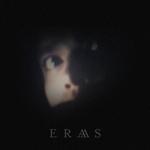
ERAAS s/t
(Felte)
An intentionally lush attempt at harmonizing simulated stringed instruments proves a distraction and ultimately the immediacy of A Presence winds up a more convincing starting point for the self-titled debut of ERAAS, a Brooklyn based quartet whose glacial and spatially charged gothic-tinged soundscapes take on the nuances of outsider 70s and 80s rock, translating them through some of the newer musical dialects spawned by groups like TV On The Radio and Radiohead. I felt like I was listening to Neu!’s first album when the percussion kicked in, icy cymbal taps and pulsating low end, spare guitar riffs donning reverb so as to indicate some notion of expanse. I dig the speed, the repetition, the emphasis on the snare hit and the belled smacks that flank each tap. The track’s initial onset of ghostly bells and ethereal tone sets a precedent for mood and indicates that experimental and explorative indulgences in sound are allowed to transpire, though not all of them are this strong. Such is the nature of risk.
ERAAS is a vocal band. Though live they function as a foursome, the album was recorded and produced by core members Robert Toher and Austin Stawiarz, formerly of the post-rock band, Apse. With repetitions both pulse-driven or subtle, Toher and Stawiarz use minimalist, groove-driven constructs to base their vocal harmonizing and dress every non-rhythmic element in lo-fidelity haze. Consequently, there’s a chill to ERAAS, both pertinent and consistent, and a tendency to want to harsh the mellow with intensified sonic layering.
At times, though, there seems to be a struggle to sound both full and spare and their inventiveness can suffer under the weight of the music’s texture. At Heart, for instance, though harmonizing runs prevalent, contains these factorial clunks and churns that are unfortunately buried under the bass rhythm and kick beat. Crescent, which is built mostly from ambient and shimmering sheets of flowing sound, doesn’t communicate much in terms of depth despite the distancing embellishments applied. Everything seems mid, no highs or lows, and the vocals even seem built into the song’s fabric. The payoff of Trinity, as its lengthy build up crescendos into an eventual sonic onslaught of volume, never truly results in any level of “loud.”
For me, the band’s greatest successes are achieved through their bass melodies, the scraping chug of Briar Path, the subtle throb of A Presence and At Heart and then the very smooth magnetism of Fang, which is set-up very well by one of the album’s better interludes, Crosscut. As ERAAS toys with ambient interludes and conceives odd percussive loops, the groove keeps many of these songs anchored, unable to float away into the veritable ether the album generates.
Otherwise, the David Sitek-ness of Skinning is attractive, as is the mild psychedelia of Ghost. In all, ERAAS, though fully invested in the possibilities of their vacuum and their vocal prowess, are at their best when the instruments can breathe.
9 October, 2012 - 08:35 — Sean Caldwell